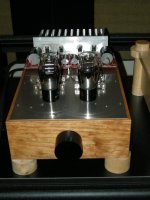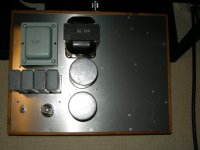Hello!
I just built a 26 preamp with 5:1 Audionote transformers and the sound is simply amazing. It smokes the 6sn7 or 5687 setup with the same output transformers on every level.
I want to go all DHT on my 300B monoblocks and have some 46 tubes that I will use as a driver. But what to choose as input tube? I probably also need 1:2 input transformers to get enough gain so can somebody give me any clues on what kind of specifications I must look for? Are the Audionotes any good?
Vidar
Which Audionote 5:1 are you using? They have quite a few ranging from pure copper wire to pure silver wire, with various core materials.
I have the cheapest copper version with double C-cores. Boy do I wish for the most expensive silver version.....Heaven knows what that must sound like.
Albertli -
Regarding temperatures, in filament bias the 10 ohm resistors get hot. 100 degrees is not tragic - I think I was getting something like that. I mounted them on top of the chassis so there would be air around them. You can barely touch them - they run hot!! Mine are rated 50 watts (four 10 ohms in series/parallel)
andy
Regarding temperatures, in filament bias the 10 ohm resistors get hot. 100 degrees is not tragic - I think I was getting something like that. I mounted them on top of the chassis so there would be air around them. You can barely touch them - they run hot!! Mine are rated 50 watts (four 10 ohms in series/parallel)
andy
Hi,
I have my 26 running and seems quite healthy.
Raw filament after rectifier, I have 0.5 ohm, 470uf, 25mH + 2 ohm, 30,000uf - I have 17.6v on this point, but the 2 ohm 10w is hot at 58c after 3 hour, then to Rod's reg. 11.5v n 10v at 10 ohm. This 10 ohm is a group of 10 100 ohm 5w dale wirewound, the temperature within these 10 are vary from 75c to 105c after 3 hours. This is what I'm a bit worry about. Is there any way I could even out the temperature ??
On Hv, I have 182v to Sala's reg. and 150v supply to 26, 145v on plate of 26. Since I have a very big heatsink for the Sala's reg. so the temperature is only around 30c after 3 hour. The square wave didn't look too good and will do some experiment this couple days.
Will upload some pics later.
Albert
Nice result Albert.
Check voltage across these resistors when temperature changes as I assume you are using them in a series parallel configuration. A more detailed description would be helpful, both channels react the same, which ones are hotter etc.
Regarding square waves on the scope, I could get them in a better shape, as well as removing a ringing at 70kHz from the ll1660, by using a 4,7k with 100nF acroos the output of the 1660, before the AVC I use at the output. I want to do more listening tests before I can comment as to this change is better or not but on the scope looks better.
My #26 preamp (220V SSHV2, Rod C. regulator, filament bias -11R-, 6mA cascode CCS, 2*0.22uF teflon coupling ) -3dB bandwith 2Hz-230kHz!The square wave didn't look too good
100kHz square wave rise- and fall time only 1us!
Last edited:
Albertli -
Regarding temperatures, in filament bias the 10 ohm resistors get hot. 100 degrees is not tragic - I think I was getting something like that. I mounted them on top of the chassis so there would be air around them. You can barely touch them - they run hot!! Mine are rated 50 watts (four 10 ohms in series/parallel)
andy
Andy,
Thanks and I'm going to have the 10 100 ohm 5w re-arranged. Will report.
Albert
Nice result Albert.
Check voltage across these resistors when temperature changes as I assume you are using them in a series parallel configuration. A more detailed description would be helpful, both channels react the same, which ones are hotter etc.
Regarding square waves on the scope, I could get them in a better shape, as well as removing a ringing at 70kHz from the ll1660, by using a 4,7k with 100nF acroos the output of the 1660, before the AVC I use at the output. I want to do more listening tests before I can comment as to this change is better or not but on the scope looks better.
George,
The voltage across 2 groups L/R are quite the same. They are 9.6v/9.63v respectively, and I'll tune them back up to 10v after the configuration. The temperature different only happens amount/ within the 10 resistors at the same group.
Will try your zobal mod and report asap
Thanks
Albert
My #26 preamp (220V SSHV2, Rod C. regulator, filament bias -11R-, 6mA cascode CCS, 2*0.22uF teflon coupling ) -3dB bandwith 2Hz-230kHz!
100kHz square wave rise- and fall time only 1us!
Would love to know more, so I could learn more.
Are you with transformer coupled ???
Thanks
Albert
No, capacitor coupled.Are you with transformer coupled ???
http://www.diyaudio.com/forums/tubes-valves/151421-26-pre-amp-156.html#post2893929
If this drives my passive attenuator (S&B Tx102 MkII copper as autoformer -AVC-), (-3dB) upper limit "only" 80kHz (low level input, -20dB below transformer saturation).
guys,
Please check photos and comment
Thanks
Albert
Albert, Looks like a nice build.
The variation in temperature should be expected, when the Power resistors are mounted close together. Up to about 150 deg C, this is no real problem, but take precautions against anyone getting burnt!
Talking of precautions, please take care that the higher-voltage end of the resistors/tag-strip does not get shorted to chassis (beware screwdrivers!), or the 10W of Resistor-power will end up in the filament regulator's Q5. The transistor can actually handle this power, given good heatsinking, but the small heatsink normally required for a 26 filament regulator may get very hot if this happens!
The filament is also protected by the regulator, in this situation. No change in current or voltage will be forced onto the filament.
Rod,
Thanks for the advice and the guidance.
The variation in temperature should be expected, when the Power resistors are mounted close together. Up to about 150 deg C, this is no real problem, but take precautions against anyone getting burnt!
I have them checked last night and found that there just couple in a group was at 105c, only on the tip but not the whole body. The other end was 20c cooler.
Talking of precautions, please take care that the higher-voltage end of the resistors/tag-strip does not get shorted to chassis
I did think about changing the tag-strip to something else more solid. Will look around for something suitable. Is one big resistor work better on this position - Stability wise, or I can buy and put them on for the chassis still have room for that.
Albert
Thanks for the advice and the guidance.
The variation in temperature should be expected, when the Power resistors are mounted close together. Up to about 150 deg C, this is no real problem, but take precautions against anyone getting burnt!
I have them checked last night and found that there just couple in a group was at 105c, only on the tip but not the whole body. The other end was 20c cooler.
Talking of precautions, please take care that the higher-voltage end of the resistors/tag-strip does not get shorted to chassis
I did think about changing the tag-strip to something else more solid. Will look around for something suitable. Is one big resistor work better on this position - Stability wise, or I can buy and put them on for the chassis still have room for that.
Albert
Did you check the Zobel on your output trafo regarding square waves? Massive nice sink on the regs, chunky general construction BTW. Nice. I hope you don't have a cat though with a taste for exploring red boards.😉
Did you check the Zobel on your output trafo regarding square waves? Massive nice sink on the regs, chunky general construction BTW. Nice. I hope you don't have a cat though with a taste for exploring red boards.😉
Sala's
Thanks for the comment. I don't have a cat, but I have a big German Shepard. My dog really doesn't care and he goes away every time I turn the volume up. I have to keep an eye on my grandson though, he is 11 months and learning to walk. I made a simple pcb as a platform for the zobel. I thought this will be easier for add on/ replace parts. Will report asap
Albert
Surely cover the reg red boards somehow so no fingers can ever touch the parts, keeping an eye is never full proof when kids are around, and lethal voltage areas are exposed. Maybe with perspex.
Rod,
Thanks for the advice and the guidance.
<snip>
I did think about changing the tag-strip to something else more solid. Will look around for something suitable. Is one big resistor work better on this position - Stability wise, or I can buy and put them on for the chassis still have room for that.
Albert
The very large Vitreous enamelled Wirewounds may give good sound, but even these have large exposed terminals. The Russian types that Andy gave the example, they look like they are worth trying.
But the big advantage of 10x parallel resistors is that the current-noise caused by the end-cap attachment (or wire termination) is reduced by paralleling. This could make a big difference to the sound, because the current is at the 1A level. for the same reason, series-connected power resistors would be a bad idea.
I would probably leave well alone, except to add some terminal insulation. Maybe you'll get the chance to try some other resistors in the future, but for now, I would do some good listening!
Surely cover the reg red boards somehow so no fingers can ever touch the parts, keeping an eye is never full proof when kids are around, and lethal voltage areas are exposed. Maybe with perspex.
This is my concern too. Thanks
The very large Vitreous enamelled Wirewounds may give good sound, but even these have large exposed terminals. The Russian types that Andy gave the example, they look like they are worth trying.
But the big advantage of 10x parallel resistors is that the current-noise caused by the end-cap attachment (or wire termination) is reduced by paralleling. This could make a big difference to the sound, because the current is at the 1A level. for the same reason, series-connected power resistors would be a bad idea.
I would probably leave well alone, except to add some terminal insulation. Maybe you'll get the chance to try some other resistors in the future, but for now, I would do some good listening!
Thanks and I have some new idea in mind. I'm going to replace the tag-strip, see if that helps even out the temperature.
- Home
- Amplifiers
- Tubes / Valves
- #26 pre amp


